
A Dictionary of the Fuchsia™
Want to know what those mysterious terms mean and just who the people were behind those names? Then this is the place for you.
Want to know what those mysterious terms mean and just who the people were behind those names? Then this is the place for you.
Gadsby, Clifford (1920-1978) – British fuchsia breeder who was responsible for over eighty cultivars registered between 1968 and 1980. Among his many achievements are Bishop's Bells, Bon Accorde, Caroline, Chillerton Beauty, Cliff’s Hardy, Cloverdale Pearl, Forward Look, Grace Darling, Lady Isobel Barnett, Lady Thumb, Jean Burton, Prosperity, Rosedale, Strawberry Delight, Upward Look and White Bride. He bred many upright plants that were especially vigorous growers, free-flowering and self-branching, and single flowers which were noted for their long curving sepals and often bell-shaped corollas. After his death, the British Fuchsia Society established the Cliff Gadsby Medal in his honor.
Full list: Upward Look (1964), Cliff's Hardy (1966), Arthur Cope, Bernard Rawdin, Diana Wills, Ice Cap, Jean Burton, Karan, Lady Isobel Barnett, Margaret Roe, Martyn Smedley, Merry England, Miss Great Britain, Rosabell, Royal Ruby, Sunny Smiles (1968), Strawberry Delight, Trudy (1969), Bishop's Bells, Blue Bush, Blue Bush, Corentine, Crown Derby, Deborah, Derby Belle, Frosty Bell, Ivan Gadsby, Lady Bower, Magenta Flush, Prosperity, Robert Hall, Royal Sovereign, Shady Blue, Skyway, Slender Lady, Strawberry Supreme, Trubell, White Bride (1980), Flash Light (1971), Albion, Cloverdale, Forward Look, George Roe, Grace Darling, Joan Pacey, Rosedale, Shy Look (1972), Derby Countess, Gay Anne, Nicolina, Rose Bower, Saxondale, Sherwood, Vale of Belvior (1973), Blue Range, Christine Clements, Cloverdale Jewel, Cloverdale Pearl, Derby Improved, Gold Leaf, Plenty, Radcliffe Beauty, Wilf Tolley (1974), Anthea Bond, Belvoir Beauty, Carl Drude, Chatsworth, Derby Pink, Derby Star, Edale, Elizabeth Broughton, Freestyle, Gay Future, Hathersage, Morning Glow, Queen of Derby, Sweet Revenge, Wee Lass (1975), Cliff's Unique, Cloverdale Star (1976), Angela Rippon, Chartwell, Cliff's Own, Cloverdale Delight, Dr. Brendan Freeman, Joan's Delight (1977), Ann Pacey, City of Derby, Garden Beauty, Margaret Thatcher, Pamela Hutchinson (1978), Belinda Allen, Cloverdale Joy, Cloverdale Pride, Rachel Catherine (1979), Clifford Gadsby (1980).
Gall Mite – See ➤ Fuchsia Gall Mite.
Garlepp, Gustav (1862-1897) – Garlepp was a German plant, insect and bird hunter active in South America from 1883-1897. See F. garleppiana in ➤ Section Hemsleyella.
Garleppiana – Named in honor of Gustav Garlepp (1862-1897). See ➤ Garlepp; F. garleppiana in ➤ Section Hemsleyella.
Gehriger, Wilhelm (dates unknown) – Wilhelm Gehriger (dates unknown) was an obscure plant collector who was active in Venezuela and adjacent areas in Brazil mostly between 1929 and 1931. Gehriger made numerous collections during those years, especially in the region around Mérida, which are now housed in various American herbaria. His specimens are sometimes recorded in association with the prominent American ornithologist Ernest G. Holt (1889-1983), as part of the National Geographic Society Boundary Survey undertaken in Venezuela during the same years as Gehriger's activity. He is also noted collecting in association with the eminent Swiss-born engineer, geographer and botanist Henri Pittier (1857-1950), "Father" of Venezuela's national park system and after whom the Henri Pittier National Park was named. Outside of his actual collections, and a single folder containing specimen lists located in the Smithsonian Archives, almost nothing is recorded on Gehriger but he does to have lent invaluable assistance to other researchers exploring in that country and a good number of his collections are now type specimens. His collection of a fuchsia from Murcurubé in Mérida (Venezuela) in 1930 would be described in his honor, without comment unfortunately, by Munz in 1943 from the type deposited with the U. S. National Herbarium. This same fuchsia was apparently collected by Alfredo Jahn Hartman already in 1921. It would be described by Munz as F. jahnii in the same publication in 1942. However, F. jahnii is now synonymous with F. gehrigeri (Berry 1982). See F. gehrigeri in ➤ Section Fuchsia.
Gehrigeri – Named in honor of Wilhelm Gehriger (dates unknown). See ➤ Gehriger; F. gehrigeri in ➤ Section Fuchsia.
Genera – Latin plural of ➤ genus.
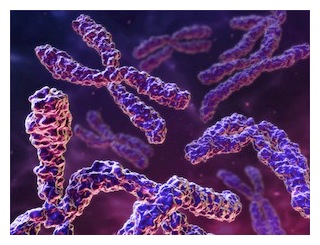 Genes – The individual genetic units strung along in the chromosome which each express particular characteristics or traits of the plant.
Genes – The individual genetic units strung along in the chromosome which each express particular characteristics or traits of the plant.
Genotype – A plant's characteristics as laid out in its inherited genetic code. This is different from a ➤ phenotype.
Genus – (Pl. genera, or often anglicized to genuses in non-scientific writings.) A grouping of several closely related species. The genus is a low level grouping but certainly the most primary as it has served as a sort of surname for all plants in its group since Linnaeus. A plant's species classification is placed immediately after the genus and related genera are grouped into families. The genus Fuchsia, belonging to the Onagraceae, or Evening Primrose Family, currently consists of over a hundred species. Note that the genus is capitalized followed by the species epithet in lower case. Both names are conventionally set in italics (or underlined). Subspecific conjunctions such as subsp. or var. within a name, however, are not italicized. For example, Fuchsia regia subsp. reitzii.
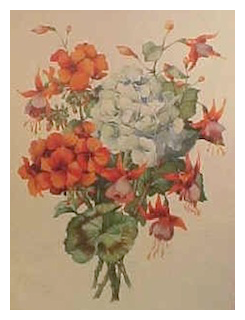 Geraniums – Fuchsias and Germaniums. Geraniums and Fuchsias. Or in their Pelargonium taxonomic incarnation. Many European horticultural societies and garden groups are surprisingly dedicated to growing both fuchsias and geraniums, the latter also known by their more proper botanical name, pelargoniums. This odd coupling dates back to the early nineteenth century when both plants were fairly new but had quickly become two of the most fashionable and popular potted plants for the parlor windowsill, conservatory and summer garden. Because of some similarities in over-wintering in a cool greenhouse or windowsill, they soon become linked in popular perceptions, despite the fact that geraniums prefer it sunny, hot and dry and fuchsias like their climate very much more cool, moist and shady. Treatment aside, it was probably contemporary snob appeal that seems to have originally joined the pair so inseparably more than anything else. The Florist and Garden Miscellany of 1850, for example, specifically points to parapet walls "ornamented at intervals with vases filled with Scarlet Geraniums, Fuchsias, etc." as part of the "noble effect" of one flower garden. What Victorian could resist such a warrant for one's own well-bred garden? The odd pair have endured until today.
Geraniums – Fuchsias and Germaniums. Geraniums and Fuchsias. Or in their Pelargonium taxonomic incarnation. Many European horticultural societies and garden groups are surprisingly dedicated to growing both fuchsias and geraniums, the latter also known by their more proper botanical name, pelargoniums. This odd coupling dates back to the early nineteenth century when both plants were fairly new but had quickly become two of the most fashionable and popular potted plants for the parlor windowsill, conservatory and summer garden. Because of some similarities in over-wintering in a cool greenhouse or windowsill, they soon become linked in popular perceptions, despite the fact that geraniums prefer it sunny, hot and dry and fuchsias like their climate very much more cool, moist and shady. Treatment aside, it was probably contemporary snob appeal that seems to have originally joined the pair so inseparably more than anything else. The Florist and Garden Miscellany of 1850, for example, specifically points to parapet walls "ornamented at intervals with vases filled with Scarlet Geraniums, Fuchsias, etc." as part of the "noble effect" of one flower garden. What Victorian could resist such a warrant for one's own well-bred garden? The odd pair have endured until today.
(Illustration: Bouquet of fuchsias and geramiums. Percy King, about 1900.)
Gesneriana – Often referring to the early Swiss naturalist and bibliologist, Conrad Gesner (1516-1565), but, in the case of Fuchsia, gesneriana is probably a reference to Jean Gesner (1709-1790), another Swiss botanist and physician who taught at the University of Leyden. His Tabulae Phytographiae was published posthumously in 1795–1804. Fuchsia fulgens var. gesneriana is a synonym of F. fulgens in ➤ Section Ellobium. It is often stated to have been discovered in 1836 by one “Barbet” on the slopes of Santa Maria Volcano in Guatemala. A fuchsia by this name is still grown in the United Kingdom. However, this plant is actually a hybrid of F. fulgens x F. splendens; it should be labelled F. fulgens ‘Gesneriana’. Gesneriana was not included in Breedlove et al.1982 as a variation of F. fulgens. The discrepancy of its origin remains to be resolved.
Giant Genus – A genus that contains five hundred or more species. At about 110 species, the term does not apply to Fuchsia.
Giffart, Pierre (1643-1723) – French printmaker who engraved the illustrations for Charles Plumier's Nova plantarum americanarum genera published in Paris in 1703, The genus Fuchsia was first named and described by Plumier in this work and was accompanied by an engraving done by Giffart after Plumier's own drawing of Fuchsia triphylla.
Gigantism – In botany, plants that exhibit excessive size due to polyploidy.
Glaberrima – Smooth. See F. glaberrima in ➤ Section Fuchsia.
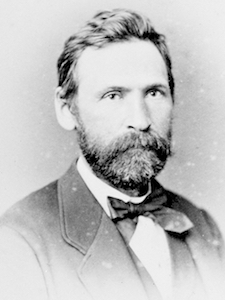 Glaziou, August (1828-1906) – Auguste François Marie Glaziou (1828-1906). Glaziou was a French landscape designer and botanist. At the request of Brazilian Emperor Dom Pedro II, he came to Rio de Janeiro in 1858 to be director of parks and gardens. See F. glazioviana in ➤ Section Quelusia. See F. glazioviana in ➤ Section Quelusia.
Glaziou, August (1828-1906) – Auguste François Marie Glaziou (1828-1906). Glaziou was a French landscape designer and botanist. At the request of Brazilian Emperor Dom Pedro II, he came to Rio de Janeiro in 1858 to be director of parks and gardens. See F. glazioviana in ➤ Section Quelusia. See F. glazioviana in ➤ Section Quelusia.
Glazioviana – Named in honor of Auguste François Marie Glaziou (1828-1906). See ➤ Glaziou; F. glazioviana in ➤ Section Quelusia.
Globifera – Bearing a round head or sphere. An unresolved fuchsia species F. globifera (Jasques 1835) published in Ann. Fl. Pomone 1834-1835: 246 1835.
Globosa – Spherical. F. globosa (Lindley 1833) is a synonym of F. magellanica (Lamarck 1788) in ➤ Section Quelusia.
Gracilis – Graceful, slender. F. gracilis (Lindley 1824), F. gracilis var. macrostemma (Ruiz & Pavon, Lindley 1827), F. gracilis var. multiflora (Lindley 1827) and F. gracilis var. tenella (Lindley 1827) are all synonyms of F. magellanica (Lamarck 1788) in ➤ Section Quelusia. F. gracilis (Moç. & Sessé ex DC 1828) is invalid and a synonym of F. microphylla (Kunth 1823) in ➤ Section Encliandra.
Grandiflora – Having large flowers. F. grandiflora (Ruiz & Pavon) is an unresolved name.
Golden Fuchsia – Usually intended to mean Deppea splendens (see also). Rare in cultivation, it's a member of the Coffee Family and now extinct in the wild. See the entry in this Dictionary on Faux Fuchsias as well as the page at ➤ Faux Fuchsias.
 Green, Dave (d. 2013) – Ardent amateur British collector of fuchsia species in South America and habitat conservationist. Green and his wife, Eileen Waters, undertook several fuchsia-hunting expeditions to the Andes, where they even discovered a novel species, ➤ Fuchsia aquaviridis. It was to be described in honor of the couple by Dr. Paul Berry, the leading scientific expect publishing on the genus, in 2007. Greatly concerned with preserving fuchsias and their habitat, he founded the ➤ Fuchsia Species Conservation Alliance (FUSCA). The group now seems in abeyance with his recent death. Green also published a large book in paperback, Fuchsia Species, on his collecting and a wealth of other information on the genus in 2011 just before his unfortunate death.
Green, Dave (d. 2013) – Ardent amateur British collector of fuchsia species in South America and habitat conservationist. Green and his wife, Eileen Waters, undertook several fuchsia-hunting expeditions to the Andes, where they even discovered a novel species, ➤ Fuchsia aquaviridis. It was to be described in honor of the couple by Dr. Paul Berry, the leading scientific expect publishing on the genus, in 2007. Greatly concerned with preserving fuchsias and their habitat, he founded the ➤ Fuchsia Species Conservation Alliance (FUSCA). The group now seems in abeyance with his recent death. Green also published a large book in paperback, Fuchsia Species, on his collecting and a wealth of other information on the genus in 2011 just before his unfortunate death.
(Illustration: Dave Green collecting F. apetala in Peru.)
Green, Dave, and Eileen Waters – See ➤ Fuchsia aquaviridis.
Greenfly – See Aphids.
Gynodioecious, Gynodioecism – A dimorphic breeding system in plants in which the species population is divided into individuals with pistillate or female flowers that coexist with hermaphroditic individuals. Some fuchsias, such as F. microphylla, exhibit this evolutionary adaptation. See also ➤ Dioecious, ➤ Perfect Flowers.
Hamellioides – Resembling plants of the genus Hamellia (properly Hamelia), also known as firebush or hummingbird bush. F. hamellioides (Moc. & Sessé ex G. Don 1832) is a synonym of F. paniculata (Lindley 1856) in ➤ Section Schufia.
Handisyd, George (flourished ca. 1670-1700?) – Ship's surgeon aboard the British East Indiaman Modena who made the earliest recorded collection of plants in the Tierra de Fuego sometime just before July, 1690. Little is known of Handisyd (modern spelling Handyside) except that he sent the botanic specimens he collected in the Magellanic region and elsewhere on to his friend Sir Hans Sloane (1660-1753), the noted British physician and collector. Among the Handisyd collections preserved with Sloane's autograph notes on folio 128 in the eighth volume of his herbarium—now held by the Natural History Museum in London—is the earliest known specimen of a plant that was later to be published by Lamarck (1774-1829) as F. magellanica in 1788. The accompanying note in Sloane's hand reads, "This Mr. Handisyd gathered in the streights of Magellan. It bears a figg as he told me which was eatable on it fed blackbirds it grew to the heighth of a small tree, it had a green bark & brittle wood." Interestingly, Handisyd also sent plant specimens to Sloane from New England, Barbados and Jamaica, as well as Hispaniola, where Charles Plumier was botanizing at about the same period. See also ➤ Sloane.
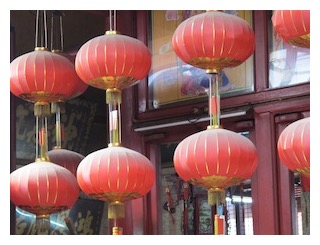
Hanging Lantern Flower – 吊 灯 花 or Diàodēnghuā. Novel descriptive name coined for the fuchsia in Chinese.
(Illustration: Red bud-like lanterns outside a Chinese temple above, and real fuchsia buds below.)
Hardwood Cutting – A cutting taken, usually in the very late summer or fall, from ripened wood on the current year's growth. Such cuttings can also be taken when the plant is dormant and has shed its leaves. Fuchsias, in fact, can often be propagated from even older wood simply by sticking plain fresh hardwood sticks into an appropriate rooting material or even the ground. Such sticks, sometimes referred to a pencils, are an easy way to transport fuchsias for propagation elsewhere with greatly reduced risks of also transporting insects or disease when properly treated and sanitized. See also The Urban Fuchsia Blog ➤ Of Pencils and Plants.
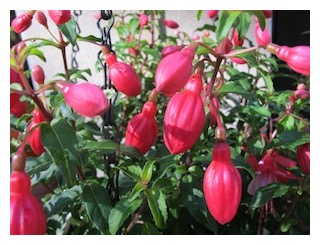
Harling, Gunnar Wilhelm (1920-2010) – Harling was a Swedish botanist who collected widely on expeditions in Ecuador and was the author of an acclaimed work on the plants of that country, Flora of Ecuador. He was an assistant at the Bergius Botanic Garden from 1950 to 1952, associate professor of botany at the University of Stockholm from 1951–1963 and professor of botany at the University of Gothenburg, where he was also director of the Botanic Museum of Gothenburg, from 1964 until his retirement. See F. harlingii in ➤ Section Fuchsia.
Harlingii – Named in honor of Gunnar Wilhelm Harling (1920-2010). See ➤ Harling; F. harlingii in ➤ Section Fuchsia.
Harlow Carr National Collection of Fuchsia sect. Quelusia – See ➤ National Collections (UK).
Hartweg, Karl Theodor (1812-1871) – Hartweg was a German botanist and horticulturalist who collected numerous new species in Colombia, Ecuador, Guatemala, Mexico and California in the United States for the Horticultural Society of London. Among his collections in South America were a number of fuchsias. After the expedition to California in1846, he returned to Germany where he became director of the splendid gardens at Schwetzingen Palace for the Grand Duke of Baden, a post he held until his death. See F. hartwegii in ➤ Section Fuchsia.
Hartwegii – Named in honor of Karl Theodor Hartweg (1812-1871). See ➤ Hartweg; F. hartwegii in ➤ Section Fuchsia.
Hardy Fuchsia – Occasionally used as a common name for F. magellanica and its similarly appearing hybrids and garden selections.
Hardy Fuchsias or Hardies – Fuchsias that will overwinter successfully in the ground outdoors. This is generally in areas with a UDSA climate zone from about 7 to about 9 or 10. A number of factors besides average low temperatures, such as summer heat or winter wet, must also be taken into account when rating the cold hardiness and winter survival of fuchsias in any climate. In the colder parts of their range, they will die back to the ground and sprout again in the spring from below ground. A number of the hardiest fuchsias, such as the Magellanica hybrids, will withstand even colder winters when sited favorably and given some winter protection. The Northwest Fuchsia Society (USA) maintains an ongoing ➤ list of fuchsias that have proven hardy over at least three winters in the Pacific Northwest region of the United States.
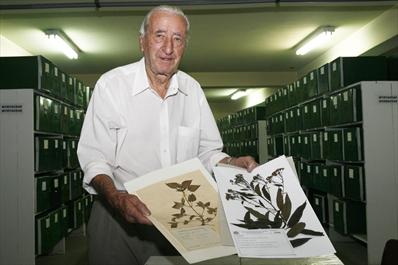 Hatschbach, Gerdt Guenther (1923-2013) – Hatschbach was a noted Brazilian professor, botanist, and taxonomist instrumental in the collection and study of the flora of the state of Paraná in Brazil. He was founder and long-time director of the Museu Botânico Municipal de Curitiba at the Jardim Botânico Francisca Maria Garfunkel Richbieter in Curitiba, the capital of Paraná State. In 1989 Paul Berry dedicated a new species that he dubbed F. hatschbachii to "Gert [sic] Hatschbach, Director of the Museu Botânico Municipal de Curitiba, who has done more than any previous botanist to collect and study the flora of Paraná". Hatschbachia, Hatschbachiella, and a large number of primarily orchid species also bear his name. His author's abbreviation is Hatschb. See F. hatschbachii in ➤ Section Fuchsia.
Hatschbach, Gerdt Guenther (1923-2013) – Hatschbach was a noted Brazilian professor, botanist, and taxonomist instrumental in the collection and study of the flora of the state of Paraná in Brazil. He was founder and long-time director of the Museu Botânico Municipal de Curitiba at the Jardim Botânico Francisca Maria Garfunkel Richbieter in Curitiba, the capital of Paraná State. In 1989 Paul Berry dedicated a new species that he dubbed F. hatschbachii to "Gert [sic] Hatschbach, Director of the Museu Botânico Municipal de Curitiba, who has done more than any previous botanist to collect and study the flora of Paraná". Hatschbachia, Hatschbachiella, and a large number of primarily orchid species also bear his name. His author's abbreviation is Hatschb. See F. hatschbachii in ➤ Section Fuchsia.
Hatschbachii – Named in honor of Gerdt Guenther Hatschbach (1923-2013) in 1989. See ➤ Hatschbach; F. hatschbachii in ➤ Section Fuchsia.
Heel – A small strip of bark that remains attached to a shoot when it's torn from a larger branch to be used for propagation. Semi-ripe cuttings are often taken with such "heels" attached.
Herbarium – (Plural herbaria, herbariums.) A collection of dried plant specimens which are mounted, labeled and systematically arranged for use in scientific study. Also the institution or place where such a collection is kept.
Hemsley, William Botting (1843-1924) – Hemsley was a botanist who published on the flora of Central America and was Keeper of the Herbarium and Library at Kew Gardens. He published a paper on "The Apetalous Fuchsias of South America" in the Journal of Botany (14:69-70) in 1875. See F. microphylla ssp hemsleyana in ➤ Section Hemsleyella.
Hemsleyana, Hemsleyella – Named in honor of William Botting Hemsley (1843-1924). F. hemsleyana is a synonym of F. microphylla ssp. hemsleyana (Woodson & Seibert, Breedlove 1937) in ➤ Section Hemsleyella.
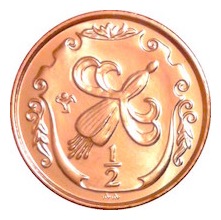 Heraldry of the Fuchsia – Despite their great popularity in the greenhouse and the garden from their first introduction into cultivation in England in the 1790s, fuchsias are curiously virtually nonexistent on heraldic shields and coats of arms. Perhaps the most significant appearance of the fuchsia in heraldry occurs on the Isle of Man. In the great tradition of the floral badge in the British Isles, such the rose of England and the thistle of Scotland, the fuchsia is now often seen as a Manx symbol. The association is evident to anyone who have visited: Fuchsia magellanica hybrids are widely naturalized there. In 1984 and 1985, a fuchsia blossom is even found on the reverse of the half penny in sets of the commemorative coinage for which the island is known. Despite being set on a shield, however, this half penny is still not a proper coat of arms but the use of the fuchsia as a floral badge.
Heraldry of the Fuchsia – Despite their great popularity in the greenhouse and the garden from their first introduction into cultivation in England in the 1790s, fuchsias are curiously virtually nonexistent on heraldic shields and coats of arms. Perhaps the most significant appearance of the fuchsia in heraldry occurs on the Isle of Man. In the great tradition of the floral badge in the British Isles, such the rose of England and the thistle of Scotland, the fuchsia is now often seen as a Manx symbol. The association is evident to anyone who have visited: Fuchsia magellanica hybrids are widely naturalized there. In 1984 and 1985, a fuchsia blossom is even found on the reverse of the half penny in sets of the commemorative coinage for which the island is known. Despite being set on a shield, however, this half penny is still not a proper coat of arms but the use of the fuchsia as a floral badge.
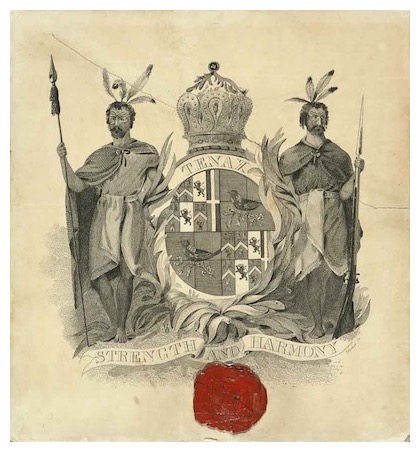
For another example, one has to go further afield. Much further. To the South Pacific in fact. But even there, the heraldic fuchsia is more fanciful than real. Not unsurprisingly, a tui-bird sits on a flowering branch of the kotukutuku, Fuchsia excorticata, the native tree fuchsia of New Zealand, in the second and third quarters in the drawing of a proposed coat of arms for the Anglo-French adventurer, Charles de Thierry (1793-1864). Thierry was apparently born on the road as his family fled the French Revolution for England, where his father appears to have assumed the title of "baron" to mask more humble origins.
Raised in England and educated at Magdalen College, Oxford and apparently Cambridge, the younger Thierry seems to have continued that family tradition of social advancement when he tried to set himself up as a sort of sovereign in chief in 1837 over a claim of 40,000 acres in New Zealand that he had supposedly purchased with an arms trade fifteen years earlier from a Maori chief visiting England with the colorful missionary, Thomas Kendall. This was not the first of Thierry's lofty schemes. During his previous travels after he arrived in the Pacific in 1835, he had even proclaimed himself the "King of Nuku Hiva" when he visited the Marquesas Islands.
Thierry’s New Zealand folly evaporated after his actual arrival when the local Maori chiefs refused his kind services to be their monarch and the motley contingent of sixty colonists he had picked up in Australia rioted and fled. Alarmed at the armed troubles Thierry had stirred up, and the lure of other adventurers or European countries to the area, the British were moved to formalize control of New Zealand by 1840.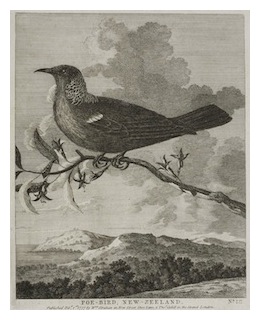 Despite the evaporation of his grand designs, an impoverished Thierry remained in the British colony and ended life as a piano teacher in Auckland in 1864.
Despite the evaporation of his grand designs, an impoverished Thierry remained in the British colony and ended life as a piano teacher in Auckland in 1864.
As for Thierry's fabulous coat of arms, the unknown artist who drew this quasi-royal heraldic achievement obviously lifted the fuchsia and bird composition directly from an uncredited illustration found in James Cook’s A Voyage Towards the South Pole, and Round the World (1777) drawn after ➤ John Forster and his son, George. There the bird is identified as the “poe-bird” and the fuchsia as “Skinnera excorticata”. Cook’s book would certainly have been readily available in London or Cambridge to serve as a model for both the unknown artist and a younger Thierry’s ambitious dreams of the South Seas and later travels.
(Illustrations: 1. Reverse of a half penny of the Isle of Man, 1984; 2. Artist unknown. Tenax, Strength and Harmony. Armes du Baron de Thierry, Charles 1er, roi de la Nouvelle Zélande. Warner sc[ulpsit]. [London or Cambridge? ca 1825 or 1840]. Ref: A-320-026. Alexander Turnbull Library, Wellington, New Zealand. http://natlib.govt.nz/records/22851248; 3. Poe-Bird, New Zealand. James Cook, A Voyage Towards the South Pole, and Round the World, 1777. The plate shows a “poe-bird” perched on a flowering branch of Skinnera excorticata (Fuchsia excorticata) drawn after Forster & Forster.)
Herzogii – Named in honor of the German bryologist and phytogeographer, T. K. G. Herzog (1880–1961). F. herzogii (Lew.) is an unresolved name.
Heterotricha – Differently hairy. F. heterotricha (Lundell 1940) is an unresolved name.
Hidalgensis – From the state of Hidalgo in Mexico. See F. microphylla ssp. hidalgensis in ➤ Section Encliandra.
Hirtella – Somewhat hairy, a little hairy. See F. hirtella in ➤ Section Fuchsia.
Hirsuta – Hairy. F. hirsuta (Hemsley 1876) is a synonym of F. apetala (Ruiz & Pavón 1802) in ➤ Section Hemsleyella.
Hirta – Hairy. F. hirta (Kunth ?) is an unresolved name.
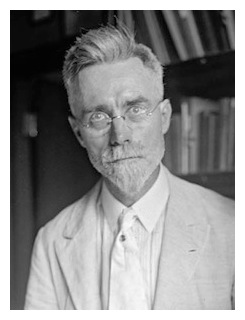 Hitchcock, Albert Spear (1865-1835) – Hitchcock was an American botanist who specialized in the Gaminaceae family. He first studied at Iowa State Agricultural College where he was influenced by Charles E. Bessey, a pioneer in the study of plant morphology in the United States. After receiving his M.S. degree in 1886, he taught chemistry at Iowa State University until 1889. He later served as the chief botanist for the United States Department of Agriculture from 1928-1935 and initiated the practice of using type specimens (holotypes) for plant nomenclature. His original collection of F. hitchcockii (Johnston 1925) is now synonymous with F. vulcanica (André 1888). See f. vulcanica ➤ Section Fuchsia.
Hitchcock, Albert Spear (1865-1835) – Hitchcock was an American botanist who specialized in the Gaminaceae family. He first studied at Iowa State Agricultural College where he was influenced by Charles E. Bessey, a pioneer in the study of plant morphology in the United States. After receiving his M.S. degree in 1886, he taught chemistry at Iowa State University until 1889. He later served as the chief botanist for the United States Department of Agriculture from 1928-1935 and initiated the practice of using type specimens (holotypes) for plant nomenclature. His original collection of F. hitchcockii (Johnston 1925) is now synonymous with F. vulcanica (André 1888). See f. vulcanica ➤ Section Fuchsia.
(Illustration: Albert Hitchcock, 1924, National Photo Company Collection, Library of Congress, Washington, D.C.)
Hitchcockii – Named in honor of Alfred S. Hitchcock (1865-1835). His original collection of F. hitchcockii (Johnston 1925) is now synonymous with F. vulcanica (André 1888). See ➤ Hitchcock; f. vulcanica ➤ Section Fuchsia.
Hoary Fuchsia – Common name for Epilobium canum (formerly Zauschneria canum), another member of the Onagraceae Family with flowers that bear a close resemblance to those of its Fuchsia relatives. Usually more commonly called the "California Fuchsia." See ➤ Faux Fuchsias entry; ➤ Faux Fuchsias web page.
Hodges, Laura (1901-1993) and Raymond (1891-1980) – From their home in Pacific Grove, Calif., Laura and Ray Hodges were prolific amateur hybridizers of a number of enduring introductions still grown throughout the world. Together they hybridized and introduced sixty-eight cultivars, including such well-known plants as ’Army Nurse’, ‘Carmel Blue’, ‘Citation’, ’Colonial Dame’, ‘Lilibet’, ‘Merle Hodges’, ‘Miss California’, ‘Powderpuff’ and ’Tinkerbell’. They were members of the California Fuchsia Society, the National Fuchsia Society and a number of other gardening clubs. Laura Hodges received an Award of Appreciation form the American Fuchsia Society in 1985. During their long career in breeding fuchsias, the city of Pacific Grove made the fuchsia that city’s official flower in 1946.
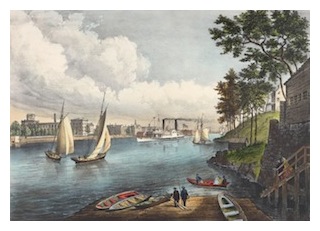 Hogg, Thomas, Jr. (1819-1892) – American plantsman who ran a family nursery business in New York City during the Nineteenth Century.
Hogg, Thomas, Jr. (1819-1892) – American plantsman who ran a family nursery business in New York City during the Nineteenth Century.
Thomas Hogg Jr. was born in London to a another leading nurseryman, Thomas Hogg Sr. (1778-1855) born in Polwarth, Scotland, who moved his family to the United States in 1820. Hogg Sr. opened a nursery and florist business in Manhattan that seems to have been originally located in the Bowery but then relocated further north to about 23rd Street and Broadway, near today's Madison Square. Business boomed but by the 1840's the firm had to move yet again even further north up the rapidly developing island. The nursery was resettled on several acres of country farm land, now at 79th Street on the East River. Hogg Sr. died in 1855, leaving the family business to his two sons, Thomas Jr. and James.
In 1862, President Abraham Lincoln sent Hogg Jr. as a customs marshal to advise Japan in developing new regulations. He remained until 1869, returning there briefly again between 1873-75. During his time in Japan, Hogg Jr. sent many plants back to the United States, especially to his brother James, who turned their nursery into one on the leading sources of Japanese and Asian plants in the country. If not the world. Among their many introductions to American horticulture is the hosta. Japanese irises, as well. A large Japanese Styrax tree planted on the grounds of James Hogg’s adjacent farmhouse only fell the the developer’s axe in the 1940s. Other leading nurserymen also benefited. Diverse Japanese maples and Cornus kousa, for example, were shipped to Samuel Parson’s nursery on Long Island.
About 1873, Hogg Jr., acquired the seeds of a fuchsia from Santo Domingo which were sent to Kew for identification. The unknown fuchsia turned out to be the long-lost species originally described by Charles Plumier in 1703 and the re-discovery of F. triphylla excited much attention. It was used in breeding the so-called Triphylla hybrids, such as 'Gartenmeister Bonstedt' and 'Thalia,' in Germany. The Hoggs sold a number of other fuchsias from their nursery, both cultivars and species such as F. boliviana and fulgens.
The standard abbreviation of this author’s name in botanical citations is T.Hogg.
(Illustration: Currier & Ives, 1862: View south from Manhattan over to Blackwell's Island (Roosevelt Island) in the East River. Hogg's Nursery was approximately a little inland from the bluff on the right, which today is at the end of East 79th Street. There was once a ferry crossing to Queens from that spot.)
Holotype – In taxonomy, the archetypical physical example of a plant or animal that was used when the species was formally described. It's either the single such example or one of several but is explicitly designated as the holotype.
Honeysuckle Fuchsia – Common name occasionally applied to F. triphylla and the ➤ triphylla hybrid group, particularly usually 'Gartenmeister Bonstedt,' from the superficial resemblance of their flowers to those of the honeysuckle (Lonicera).
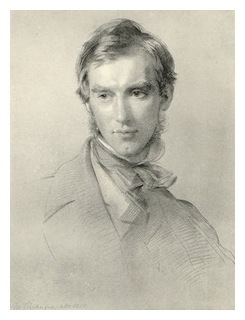 Hooker, Sir Joseph Dalton (1817-1911) – One of the greatest British botanists and explorers of the nineteenth century.
Hooker, Sir Joseph Dalton (1817-1911) – One of the greatest British botanists and explorers of the nineteenth century.
As ship's surgeon and botanist aboard the HMS Erebus and Terror, Hooker took part in the voyage of discovery to the Antarctic led by Captain James Ross from 1839-1842. From the beginning of the epic journey, which rounded the globe, Hooker collected extensively and made many new discoveries. One of the most interesting of his descriptions were of the so-called megaherbs which then grew and flowered abundantly in the acid volcanic soils and brief summers of the sub-Antarctic islands of New Zealand. His next journey was to India and the Himalayas from 1847-1851. Further expeditions would take him to Palestine (1860), Morocco (1871) and the western United States and the Rocky Mountains (1877).
Hooker was a founder of geographical botany, which studies the distributions of plants and the environmental relationships that influence these distributions. He would also become one of Charles Darwin's closest friends (see also). He had already read proofs–passed to him by mutual friend Charles Lyell–of Darwin's Voyage of he Beagle while on the Antarctic expedition and Darwin would ask him to classify the plants he had collected in South America and the Galápagos Islands when Hooker returned to England.
In 1859, just one month after Darwin's The Origin of Species was released, Hooker published the Introductory Essay to the Flora Tasmaniae in which he became the first scientist to publicly back Darwin's theory of natural selection. Hooker would later serve as director of the Royal Botanical Gardens at Kew for twenty years, having succeed his father Sir William Hooker (1785-1865) in 1865.
Hooker's path crosses fuchsias quite a number of times during his long career, especially while at the Royal Botanic Gardens. F. colensoi was first published in his Handbook of the New Zealand Flora (1867) from a specimen at Kew collected by William Colenso (see also) in 1849. Long considered a species, it has since been confirmed to be a naturally occurring hybrid between F. excorticata and F. perscandens (Berry 1995).
It is to Hooker, as well, that we owe the somewhat-mysterious sole record of Charles Darwin's collection of a fuchsia in Chile. It should logically have been among the specimens that Darwin sent on to England from the South American leg of the expedition, or perhaps part of the almost fifteen hundred specimens left on the Beagle itself with which Darwin returned to England. While the actual collection seems to have gone missing from Kew or elsewhere, Hooker specifically and detailedly ascribes "Fuchsia magellanica Lam. (Onagraceae). Prov. Aisén: Bahía San Andres, Península de Taito, 22 December 1834" in his Flora Antarctica (1844–47) to Darwin
(Illustration: Portrait of Joseph Hooker. George Richmond, 1855.)
Hortensis – Of gardens, cultivated. F. × hortensis (Bergmans 1924) is an unresolved name.
 Houstoun, Dr. William (1695-1733) – Houstoun was a British surgeon and botanist born in Scotland who collected plants in the Caribbean, Mexico and South America. He was the first botanist to collect in the Yucatan. About 1730, he sent the seeds of a fuchsia from the port city of "Carthagena in New Spain" (Cartagena de Indias is on the Caribbean coast of Colombia and was then the capital of New Granada not New Spain) to fellow Scotsman, Philip Miller, head gardener at the Chelsea Physic Garden.
Houstoun, Dr. William (1695-1733) – Houstoun was a British surgeon and botanist born in Scotland who collected plants in the Caribbean, Mexico and South America. He was the first botanist to collect in the Yucatan. About 1730, he sent the seeds of a fuchsia from the port city of "Carthagena in New Spain" (Cartagena de Indias is on the Caribbean coast of Colombia and was then the capital of New Granada not New Spain) to fellow Scotsman, Philip Miller, head gardener at the Chelsea Physic Garden.
Said to have been F. triphylla, it was apparently successfully grown by Miller for a number of years before disappearing from cultivation at some point. However, it's also possible that this fuchsia might actually have been an allied species from Section Fuchsia, such as F. nigricans, or perhaps F. gehrigeri, or even F. venusta, as Houstoun was known to have collected in Colombia and Venezuela and not Hispaniola.
Houstoun also collected plant specimens for Sir Hans Sloan, the great patron of the Chelsea Physic Garden. In 1731, he was commissioned by the trustees of the Province of Georgia to collect plants for a new physic garden at Savannah but died in Jamaica before he could accomplish his mission.
See ➤ Philip Miller.
(Illustration: Herman Moll, Map of the West Indies, 1715.)
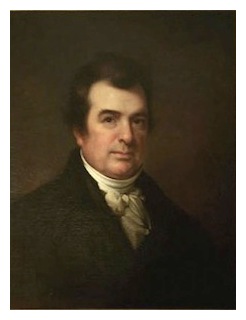 Hosack, Dr. David (1769-1835) – One of the most prominent New Yorkers of his time, Hosack was a leading physician, medical professor, botanist and even a noted mineralogist. He started the almost-mythical Elgin Botanic Garden in 1801 on a grant of fourteen acres from the City of New York for the teaching of his medical students and the benefit of the public. Since plants with medicinal qualities were essential to treating the ailments of patients, establishing such a garden was of great importance to Hosack. Interestingly, in the 1806 publication of the botanic garden's collection of over fifteen hundred plants, both F. coccinea and F. magellanica are listed. While the latter does have some limited medicinal effect as a diuretic, febrifuge and astringent, these mild properties
Hosack, Dr. David (1769-1835) – One of the most prominent New Yorkers of his time, Hosack was a leading physician, medical professor, botanist and even a noted mineralogist. He started the almost-mythical Elgin Botanic Garden in 1801 on a grant of fourteen acres from the City of New York for the teaching of his medical students and the benefit of the public. Since plants with medicinal qualities were essential to treating the ailments of patients, establishing such a garden was of great importance to Hosack. Interestingly, in the 1806 publication of the botanic garden's collection of over fifteen hundred plants, both F. coccinea and F. magellanica are listed. While the latter does have some limited medicinal effect as a diuretic, febrifuge and astringent, these mild properties seem not to have been recognized in Hosack's time: The shrubs were mostly grown for the fashion and beauty of their flowers. In spite of his personal means and considerable connections, Hosack was unable to maintain his private endeavor for long and the land was eventually purchased by the State of New York for the benefit of Columbia University in 1810. Today the Elgin Botanic Garden is a long-forgotten memory and Rockefeller Center rises where it once stood.
seem not to have been recognized in Hosack's time: The shrubs were mostly grown for the fashion and beauty of their flowers. In spite of his personal means and considerable connections, Hosack was unable to maintain his private endeavor for long and the land was eventually purchased by the State of New York for the benefit of Columbia University in 1810. Today the Elgin Botanic Garden is a long-forgotten memory and Rockefeller Center rises where it once stood.
(Illustrations: 1. Portrait of Dr. David Hosack. Rembradt Peele, oil on canvas, 1826; 2. Engraving of the greenhouses at the Elgin Botanic Garden in 1825. Fifth Avenue; Glances at the Vicissitudes and Romance of a World-renowned Thoroughfare, Fifth Avenue Bank of New York, 1915. From an original in the collection of the New York Historical Society, 1825.)
Huanucoensis – From Huánuco Province in Peru. See F. huanucoensis (P.E.Berry 1985) in ➤ Section Hemsleyella.
Huilensis – From Huila Department in Colombia. F. venusta var. huilensis Munz (1943) is a synonym of Fuchsia venusta (Kunth 1823) in ➤ Section Fuchsia.
Hybrid – A cross between two species.
Hybrida – A hybrid; a cross between two specie. Fuchsia x hybrida (Voss 1894) is a generic botanical designation for any Fuchsia hybrid or horticultural cross.
Hypanthium – The correct scientific name for the tube, the elongated part of the fuchsia's calyx.
Hypoleuca – Very pale; off white. See F. hypoleuca (I.M.Johnston 1925) in ➤ Section Fuchsia.
Full list: Upward Look (1964), Cliff's Hardy (1966), Arthur Cope, Bernard Rawdin, Diana Wills, Ice Cap, Jean Burton, Karan, Lady Isobel Barnett, Margaret Roe, Martyn Smedley, Merry England, Miss Great Britain, Rosabell, Royal Ruby, Sunny Smiles (1968), Strawberry Delight, Trudy (1969), Bishop's Bells, Blue Bush, Blue Bush, Corentine, Crown Derby, Deborah, Derby Belle, Frosty Bell, Ivan Gadsby, Lady Bower, Magenta Flush, Prosperity, Robert Hall, Royal Sovereign, Shady Blue, Skyway, Slender Lady, Strawberry Supreme, Trubell, White Bride (1980), Flash Light (1971), Albion, Cloverdale, Forward Look, George Roe, Grace Darling, Joan Pacey, Rosedale, Shy Look (1972), Derby Countess, Gay Anne, Nicolina, Rose Bower, Saxondale, Sherwood, Vale of Belvior (1973), Blue Range, Christine Clements, Cloverdale Jewel, Cloverdale Pearl, Derby Improved, Gold Leaf, Plenty, Radcliffe Beauty, Wilf Tolley (1974), Anthea Bond, Belvoir Beauty, Carl Drude, Chatsworth, Derby Pink, Derby Star, Edale, Elizabeth Broughton, Freestyle, Gay Future, Hathersage, Morning Glow, Queen of Derby, Sweet Revenge, Wee Lass (1975), Cliff's Unique, Cloverdale Star (1976), Angela Rippon, Chartwell, Cliff's Own, Cloverdale Delight, Dr. Brendan Freeman, Joan's Delight (1977), Ann Pacey, City of Derby, Garden Beauty, Margaret Thatcher, Pamela Hutchinson (1978), Belinda Allen, Cloverdale Joy, Cloverdale Pride, Rachel Catherine (1979), Clifford Gadsby (1980).
Gall Mite – See ➤ Fuchsia Gall Mite.
Garlepp, Gustav (1862-1897) – Garlepp was a German plant, insect and bird hunter active in South America from 1883-1897. See F. garleppiana in ➤ Section Hemsleyella.
Garleppiana – Named in honor of Gustav Garlepp (1862-1897). See ➤ Garlepp; F. garleppiana in ➤ Section Hemsleyella.
Gehriger, Wilhelm (dates unknown) – Wilhelm Gehriger (dates unknown) was an obscure plant collector who was active in Venezuela and adjacent areas in Brazil mostly between 1929 and 1931. Gehriger made numerous collections during those years, especially in the region around Mérida, which are now housed in various American herbaria. His specimens are sometimes recorded in association with the prominent American ornithologist Ernest G. Holt (1889-1983), as part of the National Geographic Society Boundary Survey undertaken in Venezuela during the same years as Gehriger's activity. He is also noted collecting in association with the eminent Swiss-born engineer, geographer and botanist Henri Pittier (1857-1950), "Father" of Venezuela's national park system and after whom the Henri Pittier National Park was named. Outside of his actual collections, and a single folder containing specimen lists located in the Smithsonian Archives, almost nothing is recorded on Gehriger but he does to have lent invaluable assistance to other researchers exploring in that country and a good number of his collections are now type specimens. His collection of a fuchsia from Murcurubé in Mérida (Venezuela) in 1930 would be described in his honor, without comment unfortunately, by Munz in 1943 from the type deposited with the U. S. National Herbarium. This same fuchsia was apparently collected by Alfredo Jahn Hartman already in 1921. It would be described by Munz as F. jahnii in the same publication in 1942. However, F. jahnii is now synonymous with F. gehrigeri (Berry 1982). See F. gehrigeri in ➤ Section Fuchsia.
Gehrigeri – Named in honor of Wilhelm Gehriger (dates unknown). See ➤ Gehriger; F. gehrigeri in ➤ Section Fuchsia.
Genera – Latin plural of ➤ genus.

Genotype – A plant's characteristics as laid out in its inherited genetic code. This is different from a ➤ phenotype.
Genus – (Pl. genera, or often anglicized to genuses in non-scientific writings.) A grouping of several closely related species. The genus is a low level grouping but certainly the most primary as it has served as a sort of surname for all plants in its group since Linnaeus. A plant's species classification is placed immediately after the genus and related genera are grouped into families. The genus Fuchsia, belonging to the Onagraceae, or Evening Primrose Family, currently consists of over a hundred species. Note that the genus is capitalized followed by the species epithet in lower case. Both names are conventionally set in italics (or underlined). Subspecific conjunctions such as subsp. or var. within a name, however, are not italicized. For example, Fuchsia regia subsp. reitzii.

(Illustration: Bouquet of fuchsias and geramiums. Percy King, about 1900.)
Gesneriana – Often referring to the early Swiss naturalist and bibliologist, Conrad Gesner (1516-1565), but, in the case of Fuchsia, gesneriana is probably a reference to Jean Gesner (1709-1790), another Swiss botanist and physician who taught at the University of Leyden. His Tabulae Phytographiae was published posthumously in 1795–1804. Fuchsia fulgens var. gesneriana is a synonym of F. fulgens in ➤ Section Ellobium. It is often stated to have been discovered in 1836 by one “Barbet” on the slopes of Santa Maria Volcano in Guatemala. A fuchsia by this name is still grown in the United Kingdom. However, this plant is actually a hybrid of F. fulgens x F. splendens; it should be labelled F. fulgens ‘Gesneriana’. Gesneriana was not included in Breedlove et al.1982 as a variation of F. fulgens. The discrepancy of its origin remains to be resolved.
Giant Genus – A genus that contains five hundred or more species. At about 110 species, the term does not apply to Fuchsia.
Giffart, Pierre (1643-1723) – French printmaker who engraved the illustrations for Charles Plumier's Nova plantarum americanarum genera published in Paris in 1703, The genus Fuchsia was first named and described by Plumier in this work and was accompanied by an engraving done by Giffart after Plumier's own drawing of Fuchsia triphylla.
Gigantism – In botany, plants that exhibit excessive size due to polyploidy.
Glaberrima – Smooth. See F. glaberrima in ➤ Section Fuchsia.

Glazioviana – Named in honor of Auguste François Marie Glaziou (1828-1906). See ➤ Glaziou; F. glazioviana in ➤ Section Quelusia.
Globifera – Bearing a round head or sphere. An unresolved fuchsia species F. globifera (Jasques 1835) published in Ann. Fl. Pomone 1834-1835: 246 1835.
Globosa – Spherical. F. globosa (Lindley 1833) is a synonym of F. magellanica (Lamarck 1788) in ➤ Section Quelusia.
Gracilis – Graceful, slender. F. gracilis (Lindley 1824), F. gracilis var. macrostemma (Ruiz & Pavon, Lindley 1827), F. gracilis var. multiflora (Lindley 1827) and F. gracilis var. tenella (Lindley 1827) are all synonyms of F. magellanica (Lamarck 1788) in ➤ Section Quelusia. F. gracilis (Moç. & Sessé ex DC 1828) is invalid and a synonym of F. microphylla (Kunth 1823) in ➤ Section Encliandra.
Grandiflora – Having large flowers. F. grandiflora (Ruiz & Pavon) is an unresolved name.
Golden Fuchsia – Usually intended to mean Deppea splendens (see also). Rare in cultivation, it's a member of the Coffee Family and now extinct in the wild. See the entry in this Dictionary on Faux Fuchsias as well as the page at ➤ Faux Fuchsias.

(Illustration: Dave Green collecting F. apetala in Peru.)
Green, Dave, and Eileen Waters – See ➤ Fuchsia aquaviridis.
Greenfly – See Aphids.
Gynodioecious, Gynodioecism – A dimorphic breeding system in plants in which the species population is divided into individuals with pistillate or female flowers that coexist with hermaphroditic individuals. Some fuchsias, such as F. microphylla, exhibit this evolutionary adaptation. See also ➤ Dioecious, ➤ Perfect Flowers.
Hamellioides – Resembling plants of the genus Hamellia (properly Hamelia), also known as firebush or hummingbird bush. F. hamellioides (Moc. & Sessé ex G. Don 1832) is a synonym of F. paniculata (Lindley 1856) in ➤ Section Schufia.
Handisyd, George (flourished ca. 1670-1700?) – Ship's surgeon aboard the British East Indiaman Modena who made the earliest recorded collection of plants in the Tierra de Fuego sometime just before July, 1690. Little is known of Handisyd (modern spelling Handyside) except that he sent the botanic specimens he collected in the Magellanic region and elsewhere on to his friend Sir Hans Sloane (1660-1753), the noted British physician and collector. Among the Handisyd collections preserved with Sloane's autograph notes on folio 128 in the eighth volume of his herbarium—now held by the Natural History Museum in London—is the earliest known specimen of a plant that was later to be published by Lamarck (1774-1829) as F. magellanica in 1788. The accompanying note in Sloane's hand reads, "This Mr. Handisyd gathered in the streights of Magellan. It bears a figg as he told me which was eatable on it fed blackbirds it grew to the heighth of a small tree, it had a green bark & brittle wood." Interestingly, Handisyd also sent plant specimens to Sloane from New England, Barbados and Jamaica, as well as Hispaniola, where Charles Plumier was botanizing at about the same period. See also ➤ Sloane.

Hanging Lantern Flower – 吊 灯 花 or Diàodēnghuā. Novel descriptive name coined for the fuchsia in Chinese.
(Illustration: Red bud-like lanterns outside a Chinese temple above, and real fuchsia buds below.)
Hardwood Cutting – A cutting taken, usually in the very late summer or fall, from ripened wood on the current year's growth. Such cuttings can also be taken when the plant is dormant and has shed its leaves. Fuchsias, in fact, can often be propagated from even older wood simply by sticking plain fresh hardwood sticks into an appropriate rooting material or even the ground. Such sticks, sometimes referred to a pencils, are an easy way to transport fuchsias for propagation elsewhere with greatly reduced risks of also transporting insects or disease when properly treated and sanitized. See also The Urban Fuchsia Blog ➤ Of Pencils and Plants.

Harling, Gunnar Wilhelm (1920-2010) – Harling was a Swedish botanist who collected widely on expeditions in Ecuador and was the author of an acclaimed work on the plants of that country, Flora of Ecuador. He was an assistant at the Bergius Botanic Garden from 1950 to 1952, associate professor of botany at the University of Stockholm from 1951–1963 and professor of botany at the University of Gothenburg, where he was also director of the Botanic Museum of Gothenburg, from 1964 until his retirement. See F. harlingii in ➤ Section Fuchsia.
Harlingii – Named in honor of Gunnar Wilhelm Harling (1920-2010). See ➤ Harling; F. harlingii in ➤ Section Fuchsia.
Harlow Carr National Collection of Fuchsia sect. Quelusia – See ➤ National Collections (UK).
Hartweg, Karl Theodor (1812-1871) – Hartweg was a German botanist and horticulturalist who collected numerous new species in Colombia, Ecuador, Guatemala, Mexico and California in the United States for the Horticultural Society of London. Among his collections in South America were a number of fuchsias. After the expedition to California in1846, he returned to Germany where he became director of the splendid gardens at Schwetzingen Palace for the Grand Duke of Baden, a post he held until his death. See F. hartwegii in ➤ Section Fuchsia.
Hartwegii – Named in honor of Karl Theodor Hartweg (1812-1871). See ➤ Hartweg; F. hartwegii in ➤ Section Fuchsia.
Hardy Fuchsia – Occasionally used as a common name for F. magellanica and its similarly appearing hybrids and garden selections.
Hardy Fuchsias or Hardies – Fuchsias that will overwinter successfully in the ground outdoors. This is generally in areas with a UDSA climate zone from about 7 to about 9 or 10. A number of factors besides average low temperatures, such as summer heat or winter wet, must also be taken into account when rating the cold hardiness and winter survival of fuchsias in any climate. In the colder parts of their range, they will die back to the ground and sprout again in the spring from below ground. A number of the hardiest fuchsias, such as the Magellanica hybrids, will withstand even colder winters when sited favorably and given some winter protection. The Northwest Fuchsia Society (USA) maintains an ongoing ➤ list of fuchsias that have proven hardy over at least three winters in the Pacific Northwest region of the United States.

Hatschbachii – Named in honor of Gerdt Guenther Hatschbach (1923-2013) in 1989. See ➤ Hatschbach; F. hatschbachii in ➤ Section Fuchsia.
Heel – A small strip of bark that remains attached to a shoot when it's torn from a larger branch to be used for propagation. Semi-ripe cuttings are often taken with such "heels" attached.
Herbarium – (Plural herbaria, herbariums.) A collection of dried plant specimens which are mounted, labeled and systematically arranged for use in scientific study. Also the institution or place where such a collection is kept.
Hemsley, William Botting (1843-1924) – Hemsley was a botanist who published on the flora of Central America and was Keeper of the Herbarium and Library at Kew Gardens. He published a paper on "The Apetalous Fuchsias of South America" in the Journal of Botany (14:69-70) in 1875. See F. microphylla ssp hemsleyana in ➤ Section Hemsleyella.
Hemsleyana, Hemsleyella – Named in honor of William Botting Hemsley (1843-1924). F. hemsleyana is a synonym of F. microphylla ssp. hemsleyana (Woodson & Seibert, Breedlove 1937) in ➤ Section Hemsleyella.


For another example, one has to go further afield. Much further. To the South Pacific in fact. But even there, the heraldic fuchsia is more fanciful than real. Not unsurprisingly, a tui-bird sits on a flowering branch of the kotukutuku, Fuchsia excorticata, the native tree fuchsia of New Zealand, in the second and third quarters in the drawing of a proposed coat of arms for the Anglo-French adventurer, Charles de Thierry (1793-1864). Thierry was apparently born on the road as his family fled the French Revolution for England, where his father appears to have assumed the title of "baron" to mask more humble origins.
Raised in England and educated at Magdalen College, Oxford and apparently Cambridge, the younger Thierry seems to have continued that family tradition of social advancement when he tried to set himself up as a sort of sovereign in chief in 1837 over a claim of 40,000 acres in New Zealand that he had supposedly purchased with an arms trade fifteen years earlier from a Maori chief visiting England with the colorful missionary, Thomas Kendall. This was not the first of Thierry's lofty schemes. During his previous travels after he arrived in the Pacific in 1835, he had even proclaimed himself the "King of Nuku Hiva" when he visited the Marquesas Islands.
Thierry’s New Zealand folly evaporated after his actual arrival when the local Maori chiefs refused his kind services to be their monarch and the motley contingent of sixty colonists he had picked up in Australia rioted and fled. Alarmed at the armed troubles Thierry had stirred up, and the lure of other adventurers or European countries to the area, the British were moved to formalize control of New Zealand by 1840.

As for Thierry's fabulous coat of arms, the unknown artist who drew this quasi-royal heraldic achievement obviously lifted the fuchsia and bird composition directly from an uncredited illustration found in James Cook’s A Voyage Towards the South Pole, and Round the World (1777) drawn after ➤ John Forster and his son, George. There the bird is identified as the “poe-bird” and the fuchsia as “Skinnera excorticata”. Cook’s book would certainly have been readily available in London or Cambridge to serve as a model for both the unknown artist and a younger Thierry’s ambitious dreams of the South Seas and later travels.
(Illustrations: 1. Reverse of a half penny of the Isle of Man, 1984; 2. Artist unknown. Tenax, Strength and Harmony. Armes du Baron de Thierry, Charles 1er, roi de la Nouvelle Zélande. Warner sc[ulpsit]. [London or Cambridge? ca 1825 or 1840]. Ref: A-320-026. Alexander Turnbull Library, Wellington, New Zealand. http://natlib.govt.nz/records/22851248; 3. Poe-Bird, New Zealand. James Cook, A Voyage Towards the South Pole, and Round the World, 1777. The plate shows a “poe-bird” perched on a flowering branch of Skinnera excorticata (Fuchsia excorticata) drawn after Forster & Forster.)
Herzogii – Named in honor of the German bryologist and phytogeographer, T. K. G. Herzog (1880–1961). F. herzogii (Lew.) is an unresolved name.
Heterotricha – Differently hairy. F. heterotricha (Lundell 1940) is an unresolved name.
Hidalgensis – From the state of Hidalgo in Mexico. See F. microphylla ssp. hidalgensis in ➤ Section Encliandra.
Hirtella – Somewhat hairy, a little hairy. See F. hirtella in ➤ Section Fuchsia.
Hirsuta – Hairy. F. hirsuta (Hemsley 1876) is a synonym of F. apetala (Ruiz & Pavón 1802) in ➤ Section Hemsleyella.
Hirta – Hairy. F. hirta (Kunth ?) is an unresolved name.

(Illustration: Albert Hitchcock, 1924, National Photo Company Collection, Library of Congress, Washington, D.C.)
Hitchcockii – Named in honor of Alfred S. Hitchcock (1865-1835). His original collection of F. hitchcockii (Johnston 1925) is now synonymous with F. vulcanica (André 1888). See ➤ Hitchcock; f. vulcanica ➤ Section Fuchsia.
Hoary Fuchsia – Common name for Epilobium canum (formerly Zauschneria canum), another member of the Onagraceae Family with flowers that bear a close resemblance to those of its Fuchsia relatives. Usually more commonly called the "California Fuchsia." See ➤ Faux Fuchsias entry; ➤ Faux Fuchsias web page.
Hodges, Laura (1901-1993) and Raymond (1891-1980) – From their home in Pacific Grove, Calif., Laura and Ray Hodges were prolific amateur hybridizers of a number of enduring introductions still grown throughout the world. Together they hybridized and introduced sixty-eight cultivars, including such well-known plants as ’Army Nurse’, ‘Carmel Blue’, ‘Citation’, ’Colonial Dame’, ‘Lilibet’, ‘Merle Hodges’, ‘Miss California’, ‘Powderpuff’ and ’Tinkerbell’. They were members of the California Fuchsia Society, the National Fuchsia Society and a number of other gardening clubs. Laura Hodges received an Award of Appreciation form the American Fuchsia Society in 1985. During their long career in breeding fuchsias, the city of Pacific Grove made the fuchsia that city’s official flower in 1946.

Thomas Hogg Jr. was born in London to a another leading nurseryman, Thomas Hogg Sr. (1778-1855) born in Polwarth, Scotland, who moved his family to the United States in 1820. Hogg Sr. opened a nursery and florist business in Manhattan that seems to have been originally located in the Bowery but then relocated further north to about 23rd Street and Broadway, near today's Madison Square. Business boomed but by the 1840's the firm had to move yet again even further north up the rapidly developing island. The nursery was resettled on several acres of country farm land, now at 79th Street on the East River. Hogg Sr. died in 1855, leaving the family business to his two sons, Thomas Jr. and James.
In 1862, President Abraham Lincoln sent Hogg Jr. as a customs marshal to advise Japan in developing new regulations. He remained until 1869, returning there briefly again between 1873-75. During his time in Japan, Hogg Jr. sent many plants back to the United States, especially to his brother James, who turned their nursery into one on the leading sources of Japanese and Asian plants in the country. If not the world. Among their many introductions to American horticulture is the hosta. Japanese irises, as well. A large Japanese Styrax tree planted on the grounds of James Hogg’s adjacent farmhouse only fell the the developer’s axe in the 1940s. Other leading nurserymen also benefited. Diverse Japanese maples and Cornus kousa, for example, were shipped to Samuel Parson’s nursery on Long Island.
About 1873, Hogg Jr., acquired the seeds of a fuchsia from Santo Domingo which were sent to Kew for identification. The unknown fuchsia turned out to be the long-lost species originally described by Charles Plumier in 1703 and the re-discovery of F. triphylla excited much attention. It was used in breeding the so-called Triphylla hybrids, such as 'Gartenmeister Bonstedt' and 'Thalia,' in Germany. The Hoggs sold a number of other fuchsias from their nursery, both cultivars and species such as F. boliviana and fulgens.
The standard abbreviation of this author’s name in botanical citations is T.Hogg.
(Illustration: Currier & Ives, 1862: View south from Manhattan over to Blackwell's Island (Roosevelt Island) in the East River. Hogg's Nursery was approximately a little inland from the bluff on the right, which today is at the end of East 79th Street. There was once a ferry crossing to Queens from that spot.)
Holotype – In taxonomy, the archetypical physical example of a plant or animal that was used when the species was formally described. It's either the single such example or one of several but is explicitly designated as the holotype.
Honeysuckle Fuchsia – Common name occasionally applied to F. triphylla and the ➤ triphylla hybrid group, particularly usually 'Gartenmeister Bonstedt,' from the superficial resemblance of their flowers to those of the honeysuckle (Lonicera).

As ship's surgeon and botanist aboard the HMS Erebus and Terror, Hooker took part in the voyage of discovery to the Antarctic led by Captain James Ross from 1839-1842. From the beginning of the epic journey, which rounded the globe, Hooker collected extensively and made many new discoveries. One of the most interesting of his descriptions were of the so-called megaherbs which then grew and flowered abundantly in the acid volcanic soils and brief summers of the sub-Antarctic islands of New Zealand. His next journey was to India and the Himalayas from 1847-1851. Further expeditions would take him to Palestine (1860), Morocco (1871) and the western United States and the Rocky Mountains (1877).
Hooker was a founder of geographical botany, which studies the distributions of plants and the environmental relationships that influence these distributions. He would also become one of Charles Darwin's closest friends (see also). He had already read proofs–passed to him by mutual friend Charles Lyell–of Darwin's Voyage of he Beagle while on the Antarctic expedition and Darwin would ask him to classify the plants he had collected in South America and the Galápagos Islands when Hooker returned to England.
In 1859, just one month after Darwin's The Origin of Species was released, Hooker published the Introductory Essay to the Flora Tasmaniae in which he became the first scientist to publicly back Darwin's theory of natural selection. Hooker would later serve as director of the Royal Botanical Gardens at Kew for twenty years, having succeed his father Sir William Hooker (1785-1865) in 1865.
Hooker's path crosses fuchsias quite a number of times during his long career, especially while at the Royal Botanic Gardens. F. colensoi was first published in his Handbook of the New Zealand Flora (1867) from a specimen at Kew collected by William Colenso (see also) in 1849. Long considered a species, it has since been confirmed to be a naturally occurring hybrid between F. excorticata and F. perscandens (Berry 1995).
It is to Hooker, as well, that we owe the somewhat-mysterious sole record of Charles Darwin's collection of a fuchsia in Chile. It should logically have been among the specimens that Darwin sent on to England from the South American leg of the expedition, or perhaps part of the almost fifteen hundred specimens left on the Beagle itself with which Darwin returned to England. While the actual collection seems to have gone missing from Kew or elsewhere, Hooker specifically and detailedly ascribes "Fuchsia magellanica Lam. (Onagraceae). Prov. Aisén: Bahía San Andres, Península de Taito, 22 December 1834" in his Flora Antarctica (1844–47) to Darwin
(Illustration: Portrait of Joseph Hooker. George Richmond, 1855.)
Hortensis – Of gardens, cultivated. F. × hortensis (Bergmans 1924) is an unresolved name.

Said to have been F. triphylla, it was apparently successfully grown by Miller for a number of years before disappearing from cultivation at some point. However, it's also possible that this fuchsia might actually have been an allied species from Section Fuchsia, such as F. nigricans, or perhaps F. gehrigeri, or even F. venusta, as Houstoun was known to have collected in Colombia and Venezuela and not Hispaniola.
Houstoun also collected plant specimens for Sir Hans Sloan, the great patron of the Chelsea Physic Garden. In 1731, he was commissioned by the trustees of the Province of Georgia to collect plants for a new physic garden at Savannah but died in Jamaica before he could accomplish his mission.
See ➤ Philip Miller.
(Illustration: Herman Moll, Map of the West Indies, 1715.)


(Illustrations: 1. Portrait of Dr. David Hosack. Rembradt Peele, oil on canvas, 1826; 2. Engraving of the greenhouses at the Elgin Botanic Garden in 1825. Fifth Avenue; Glances at the Vicissitudes and Romance of a World-renowned Thoroughfare, Fifth Avenue Bank of New York, 1915. From an original in the collection of the New York Historical Society, 1825.)
Huanucoensis – From Huánuco Province in Peru. See F. huanucoensis (P.E.Berry 1985) in ➤ Section Hemsleyella.
Huilensis – From Huila Department in Colombia. F. venusta var. huilensis Munz (1943) is a synonym of Fuchsia venusta (Kunth 1823) in ➤ Section Fuchsia.
Hybrid – A cross between two species.
Hybrida – A hybrid; a cross between two specie. Fuchsia x hybrida (Voss 1894) is a generic botanical designation for any Fuchsia hybrid or horticultural cross.
Hypanthium – The correct scientific name for the tube, the elongated part of the fuchsia's calyx.
Hypoleuca – Very pale; off white. See F. hypoleuca (I.M.Johnston 1925) in ➤ Section Fuchsia.





